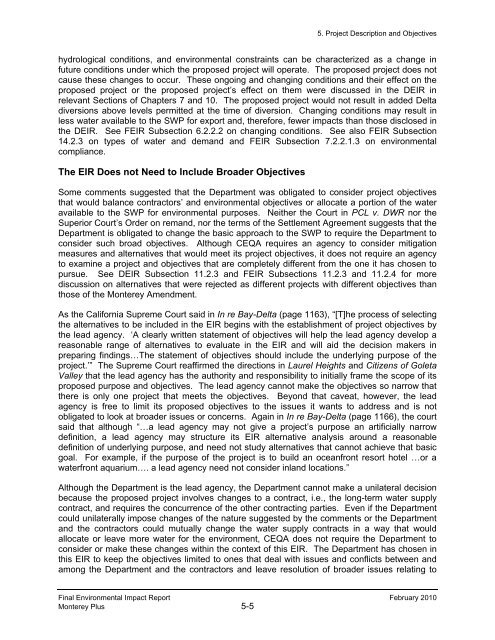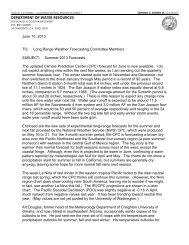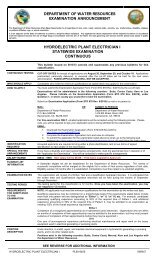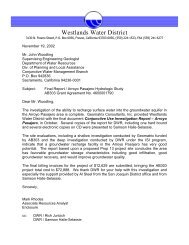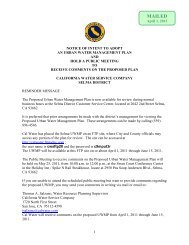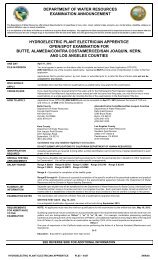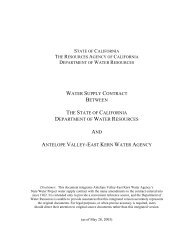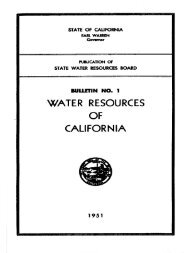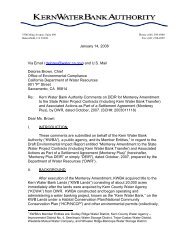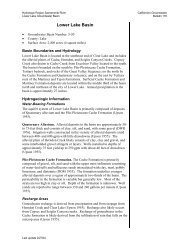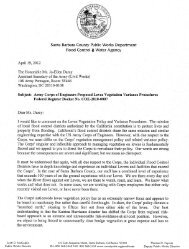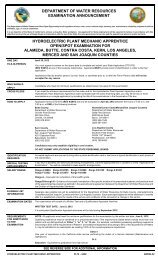- Page 1:
Final Environmental Impact Report M
- Page 5:
EIR COMMITTEE Ernest Conant, Young
- Page 9:
TABLE OF CONTENTS
- Page 12 and 13:
APPENDICES A. Comment Letters B. Hi
- Page 14 and 15:
FIGURES FEIR Figures Page 7.2-1 Est
- Page 17 and 18:
GLOSSARY Acre-Foot Volume of water
- Page 19 and 20:
Racanelli Decision Special Status S
- Page 21 and 22:
CWA Clean Water Act CWC California
- Page 23:
SJVAB San Joaquin Valley Air Basin
- Page 27 and 28:
Introduction 1. INTRODUCTION The De
- Page 29 and 30:
1 Introduction • Permanent transf
- Page 31 and 32:
1 Introduction less than significan
- Page 33 and 34:
1 Introduction Chapter 17 - Miscell
- Page 35:
San Francisco Public Library 100 La
- Page 39 and 40:
2. CHANGES TO THE DRAFT EIR TEXT, F
- Page 41 and 42:
2. Changes to the Draft EIR Text, F
- Page 43 and 44:
2. Changes to the Draft EIR Text, F
- Page 45 and 46:
TABLE 6-3 2. Changes to the Draft E
- Page 47 and 48:
TABLE 6-7 2. Changes to the Draft E
- Page 49 and 50:
TABLE 6-10 2. Changes to the Draft
- Page 51 and 52:
TABLE 6-12 2. Changes to the Draft
- Page 53 and 54:
2. Changes to the Draft EIR Text, F
- Page 55 and 56:
2. Changes to the Draft EIR Text, F
- Page 57 and 58:
2. Changes to the Draft EIR Text, F
- Page 59 and 60:
Page 7.3-10, Table 7.3-3, is revise
- Page 61 and 62:
TABLE 7.3-5 2. Changes to the Draft
- Page 63 and 64:
2. Changes to the Draft EIR Text, F
- Page 65 and 66:
2. Changes to the Draft EIR Text, F
- Page 67 and 68:
Page 7.3-37, Table 7.3-19 is revise
- Page 69 and 70:
2. Changes to the Draft EIR Text, F
- Page 71 and 72:
2. Changes to the Draft EIR Text, F
- Page 73 and 74:
Page 7.10-5, the endnote numbers ar
- Page 75 and 76:
Page 8-8, the first paragraph is re
- Page 77 and 78:
2. Changes to the Draft EIR Text, F
- Page 79 and 80:
TABLE 8-3A 2. Changes to the Draft
- Page 81 and 82:
2. Changes to the Draft EIR Text, F
- Page 83 and 84:
2. Changes to the Draft EIR Text, F
- Page 85 and 86:
2. Changes to the Draft EIR Text, F
- Page 87 and 88:
Page 11-33, Table 11-23 is revised
- Page 89 and 90:
2. Changes to the Draft EIR Text, F
- Page 91:
2. Changes to the Draft EIR Text, F
- Page 95 and 96:
3. INDEX TO COMMENTS AND RESPONSES
- Page 97 and 98:
3. Index to Comments and Responses
- Page 99 and 100:
FEIR TABLE 3-1 3. Index to Comments
- Page 101 and 102:
Letter Number Name Agency / Affilia
- Page 103 and 104: Letter Number Name Agency / Affilia
- Page 105 and 106: Letter Number Name Agency / Affilia
- Page 107 and 108: Letter Number Name Agency / Affilia
- Page 109 and 110: Letter Number Name Agency / Affilia
- Page 111 and 112: Letter Number Name Agency / Affilia
- Page 113 and 114: FEIR TABLE 3-1 3. Index to Comments
- Page 115 and 116: Letter Number Name Agency / Affilia
- Page 117 and 118: Letter Number Name Agency / Affilia
- Page 119 and 120: Letter Number Name Agency / Affilia
- Page 121: 4. INTRODUCTION AND PROCESS
- Page 124 and 125: 4. Introduction and Process The DEI
- Page 126 and 127: Transfer of KFE Property 4. Introdu
- Page 128 and 129: 4. Introduction and Process continu
- Page 130 and 131: 4. Introduction and Process trustee
- Page 132 and 133: 4. Introduction and Process Of the
- Page 134 and 135: 4. Introduction and Process Article
- Page 136 and 137: TABLE 6-3 4. Introduction and Proce
- Page 138 and 139: Response to Comment 30-2 4. Introdu
- Page 140 and 141: 4. Introduction and Process contrac
- Page 142 and 143: 4. Introduction and Process The com
- Page 144 and 145: Response to Comment 30-79 4. Introd
- Page 146 and 147: Response to Comment 30-135 4. Intro
- Page 149: 5. PROJECT DESCRIPTION AND OBJECTIV
- Page 152 and 153: 5. Project Description and Objectiv
- Page 156 and 157: 5. Project Description and Objectiv
- Page 158 and 159: 5. Project Description and Objectiv
- Page 160 and 161: 5. Project Description and Objectiv
- Page 162 and 163: 5. Project Description and Objectiv
- Page 164 and 165: 5. Project Description and Objectiv
- Page 166 and 167: 5. Project Description and Objectiv
- Page 168 and 169: Response to Comment 30-19 5. Projec
- Page 170 and 171: 5. Project Description and Objectiv
- Page 173: 6. ANALYTICAL METHODS
- Page 177: 6.0 METHODOLOGY This chapter respon
- Page 181 and 182: 6.1.1 Introduction 6.1 BASELINE The
- Page 183 and 184: projected impacts of the proposed p
- Page 185 and 186: 6.1 Baseline to the public and deci
- Page 187 and 188: 6.1 Baseline unrelated Table A tran
- Page 189 and 190: 6.1 Baseline less or more in the fu
- Page 191 and 192: 6.1 Baseline Some comments also sta
- Page 193 and 194: 6.1 Baseline based on service needs
- Page 195 and 196: 6.1 Baseline Representatives and fo
- Page 197 and 198: 6.1 Baseline existing facilities an
- Page 199: 6.2 CHANGED CONDITIONS
- Page 202 and 203: 6.2 Changed Conditions demands for
- Page 204 and 205:
6.2 Changed Conditions analysis of
- Page 206 and 207:
6.2 Changed Conditions available (D
- Page 209:
6.3 METHODS
- Page 212 and 213:
6.3 Methods features outlined in th
- Page 214 and 215:
FEIR TABLE 6.3-1 6.3 Methods ANALYT
- Page 216 and 217:
FEIR TABLE 6.3-1 ANALYTICAL METHODS
- Page 218 and 219:
6.3 Methods Some comments state tha
- Page 220 and 221:
6.3 Methods simulate the complex SW
- Page 222 and 223:
6.3 Methods analysis of historical
- Page 224 and 225:
6.3 Methods Other comments state th
- Page 226 and 227:
6.3 Methods The DEIR used CALSIM II
- Page 228 and 229:
6.3 Methods A state-owned KFE was i
- Page 230 and 231:
6.3 Methods to deliver with its exi
- Page 232 and 233:
6.3 Methods what real time operator
- Page 234 and 235:
6.3 Methods longer periods of time
- Page 236 and 237:
See also Response to Comment 16-10
- Page 238 and 239:
6.3 Methods The comment indicates t
- Page 240 and 241:
6.3 Methods The CALSIM II-based ana
- Page 242 and 243:
6.3 Methods Subsection 6.3.2.1. Thi
- Page 244 and 245:
Response to Comment 22-6 6.3 Method
- Page 246 and 247:
Response to Comment 22-10 6.3 Metho
- Page 248 and 249:
Response to Comment 22-27 6.3 Metho
- Page 250 and 251:
6.3 Methods It also states that the
- Page 252 and 253:
6.3 Methods validation of CALSIM II
- Page 254 and 255:
6.3 Methods analyses in the DEIR, i
- Page 256 and 257:
6.3 Methods significantly. In the D
- Page 258 and 259:
6.3 Methods month that the water-ye
- Page 261:
7.0 INTRODUCTION TO ANALYTICAL SECT
- Page 265:
7.1 SURFACE WATER AND GROUNDWATER H
- Page 268 and 269:
7.1 Surface Water and Groundwater H
- Page 270 and 271:
7.1 Surface Water and Groundwater H
- Page 272 and 273:
7.1 Surface Water and Groundwater H
- Page 274 and 275:
Response to Comment 16-75 7.1 Surfa
- Page 276 and 277:
7.1 Surface Water and Groundwater H
- Page 278 and 279:
7.1 Surface Water and Groundwater H
- Page 280 and 281:
7.1 Surface Water and Groundwater H
- Page 283 and 284:
7.2.1 Introduction 7.2 FISHERIES IM
- Page 285 and 286:
7.2 Fisheries Impacts The DEIR reco
- Page 287 and 288:
7.2 Fisheries Impacts a new USFWS B
- Page 289 and 290:
7.2 Fisheries Impacts 2007 interim
- Page 291 and 292:
7.2 Fisheries Impacts decreased wat
- Page 293 and 294:
7.2 Fisheries Impacts at Banks Pump
- Page 295 and 296:
7.2 Fisheries Impacts Monterey Amen
- Page 297 and 298:
7.2 Fisheries Impacts percent (or a
- Page 299 and 300:
Reliance on Existing Regulatory Pro
- Page 301 and 302:
7.2 Fisheries Impacts actions, incl
- Page 303 and 304:
7.2 Fisheries Impacts applied for m
- Page 305 and 306:
7.2 Fisheries Impacts populations i
- Page 307 and 308:
7.2 Fisheries Impacts abundances of
- Page 309 and 310:
7.2 Fisheries Impacts Subsections 7
- Page 311 and 312:
7.2 Fisheries Impacts impact, which
- Page 313 and 314:
Response to Comment 16-85 7.2 Fishe
- Page 315 and 316:
TABLE 7.3-19 AVERAGE MONTHLY FLOW C
- Page 317 and 318:
Response to Comment 17-10 7.2 Fishe
- Page 319 and 320:
7.2 Fisheries Impacts The EWA Agenc
- Page 321 and 322:
7.2 Fisheries Impacts mandated by n
- Page 323 and 324:
Response to Comment 22-30 7.2 Fishe
- Page 325 and 326:
7.2 Fisheries Impacts Water transfe
- Page 327 and 328:
FEIR TABLE 7.2-1 7.2 Fisheries Impa
- Page 329 and 330:
7.2 Fisheries Impacts document prov
- Page 331 and 332:
Response to Comment 36-1 7.2 Fisher
- Page 333 and 334:
Response to Comment 64-16 7.2 Fishe
- Page 335 and 336:
Response to Comment 65-22 7.2 Fishe
- Page 337 and 338:
TABLE 7.3-3 7.2 Fisheries Impacts S
- Page 339 and 340:
Fall-run: 7.2 Fisheries Impacts Sin
- Page 341 and 342:
7.2 Fisheries Impacts 7.2.4.2 Decli
- Page 343 and 344:
7.2 Fisheries Impacts various group
- Page 345 and 346:
TABLE 7.3-14 7.2 Fisheries Impacts
- Page 347:
7.3 TERRESTRIAL BIOLOGICAL RESOURCE
- Page 350 and 351:
Response to Comment 16-29 7.3 Terre
- Page 352 and 353:
7.3 Terrestrial Biological Resource
- Page 354 and 355:
7.3 Terrestrial Biological Resource
- Page 357 and 358:
7.4.1 Introduction 7.4 VISUAL RESOU
- Page 359:
7.5 AIR QUALITY
- Page 362 and 363:
Response to Comment 42-10 7.5 Air Q
- Page 365 and 366:
7.6.1 Introduction 7.6 GEOLOGY, SOI
- Page 367:
7.6 Geology, Soils, and Mineral Res
- Page 371:
7.7.1 Introduction 7.7 RECREATION T
- Page 375 and 376:
7.8.1 Introduction 7.8 ENERGY The f
- Page 377 and 378:
7.8 Energy highlighted in Section 7
- Page 379 and 380:
7.8 Energy Some comments asked for
- Page 381 and 382:
7.8 Energy provided by Western Area
- Page 383:
7.8 Energy through 7.8.2.5. See als
- Page 387 and 388:
8.1 INTRODUCTION 8. GROWTH-INDUCING
- Page 389 and 390:
8. Growth-Inducing Impacts extensiv
- Page 391 and 392:
8. Growth-Inducing Impacts M&I cont
- Page 393 and 394:
8. Growth-Inducing Impacts pages 8-
- Page 395 and 396:
8. Growth-Inducing Impacts growth i
- Page 397 and 398:
8. Growth-Inducing Impacts reductio
- Page 399 and 400:
8. Growth-Inducing Impacts Several
- Page 401 and 402:
FEIR TABLE 8-1 8. Growth-Inducing I
- Page 403 and 404:
8.2.4.3 Altered Allocation Procedur
- Page 405 and 406:
Potential Population Supported by I
- Page 407 and 408:
8. Growth-Inducing Impacts predicta
- Page 409 and 410:
8. Growth-Inducing Impacts this Cha
- Page 411 and 412:
Response to Comment 16-98 8. Growth
- Page 413 and 414:
Response to Comment 30-63 8. Growth
- Page 415 and 416:
8. Growth-Inducing Impacts Monterey
- Page 417 and 418:
8. Growth-Inducing Impacts As discu
- Page 419 and 420:
8. Growth-Inducing Impacts only the
- Page 421 and 422:
8. Growth-Inducing Impacts groundwa
- Page 423 and 424:
Response to Comment 64-3 8. Growth-
- Page 425 and 426:
8. Growth-Inducing Impacts � Curr
- Page 427 and 428:
8. Growth-Inducing Impacts supplies
- Page 429 and 430:
TABLE 8-3B 8. Growth-Inducing Impac
- Page 431 and 432:
8. Growth-Inducing Impacts specific
- Page 433 and 434:
8. Growth-Inducing Impacts would ha
- Page 435:
9. RELIABILITY OF WATER SUPPLIES AN
- Page 438 and 439:
9. Reliability of Water Supplies an
- Page 440 and 441:
9. Reliability of Water Supplies an
- Page 442 and 443:
9.2.2 Terminology: Table A Amounts,
- Page 444 and 445:
9. Reliability of Water Supplies an
- Page 446 and 447:
9. Reliability of Water Supplies an
- Page 448 and 449:
9. Reliability of Water Supplies an
- Page 450 and 451:
9. Reliability of Water Supplies an
- Page 452 and 453:
9. Reliability of Water Supplies an
- Page 454 and 455:
9. Reliability of Water Supplies an
- Page 456 and 457:
9. Reliability of Water Supplies an
- Page 458 and 459:
9. Reliability of Water Supplies an
- Page 460 and 461:
Climate Change and Changes to Regul
- Page 462 and 463:
9. Reliability of Water Supplies an
- Page 464 and 465:
9. Reliability of Water Supplies an
- Page 466 and 467:
Response to Comment 21-54 9. Reliab
- Page 468 and 469:
9. Reliability of Water Supplies an
- Page 470 and 471:
9. Reliability of Water Supplies an
- Page 472 and 473:
9. Reliability of Water Supplies an
- Page 474 and 475:
9. Reliability of Water Supplies an
- Page 476 and 477:
9. Reliability of Water Supplies an
- Page 479:
10. OTHER CEQA CONSIDERATIONS
- Page 482 and 483:
The fourth paragraph on page 10.1-2
- Page 484 and 485:
10. Other CEQA Considerations CVP.
- Page 486 and 487:
10. Other CEQA Considerations alter
- Page 488 and 489:
10. Other CEQA Considerations been
- Page 491:
11. ALTERNATIVES
- Page 494 and 495:
11. Alternatives the changes as a w
- Page 496 and 497:
As summarized on page 11-1 of the D
- Page 498 and 499:
11. Alternatives CNPA4 all assume t
- Page 500 and 501:
11. Alternatives Some comments aske
- Page 502 and 503:
11. Alternatives project, the alter
- Page 504 and 505:
11. Alternatives alternative that d
- Page 506 and 507:
11. Alternatives environmental purp
- Page 508 and 509:
11. Alternatives because it would n
- Page 510 and 511:
11.2.4.1.4 Demand and Water Reliabi
- Page 512 and 513:
11. Alternatives of more appropriat
- Page 514 and 515:
11. Alternatives The only change re
- Page 516 and 517:
11. Alternatives 11.2.4.2.6 Most In
- Page 518 and 519:
11. Alternatives water being delive
- Page 520 and 521:
11. Alternatives Thus, a potential
- Page 522 and 523:
Response to Comment 17-8 11. Altern
- Page 524 and 525:
11. Alternatives contractors dissat
- Page 526 and 527:
11. Alternatives rather than Table
- Page 528 and 529:
11. Alternatives 18(b) invoked. The
- Page 530 and 531:
11. Alternatives comment questions
- Page 532 and 533:
Response to Comment 36-19 11. Alter
- Page 535:
12. CLIMATE CHANGE
- Page 538 and 539:
12.2.1.1 Impacts of increased SWP P
- Page 540 and 541:
12. Climate Change Some also sugges
- Page 542 and 543:
12. Climate Change directed by Gove
- Page 544 and 545:
12. Climate Change change is alread
- Page 546 and 547:
12. Climate Change Some comments ap
- Page 548 and 549:
12. Climate Change Decision Making
- Page 550 and 551:
12. Climate Change which describes
- Page 552 and 553:
12. Climate Change equaled 3,22 mil
- Page 554 and 555:
12. Climate Change construction met
- Page 557 and 558:
13.1 INTRODUCTION 13. ARTICLE 18 Th
- Page 559 and 560:
13. Article 18 Amendment also elimi
- Page 561 and 562:
13. Article 18 The history below, w
- Page 563 and 564:
13. Article 18 should allocate supp
- Page 565 and 566:
13. Article 18 groundwater replenis
- Page 567 and 568:
13. Article 18 As stated in FEIR Su
- Page 569 and 570:
Relative Delivery FEIR Figure 13-2
- Page 571 and 572:
13. Article 18 As a result of this
- Page 573 and 574:
13. Article 18 the Monterey Agreeme
- Page 575 and 576:
13. Article 18 Delta pumping is sup
- Page 577 and 578:
13. Article 18 Also see the Respons
- Page 579 and 580:
Response to Comment 17-1 13. Articl
- Page 581 and 582:
Response to Comment 21-10 13. Artic
- Page 583 and 584:
13. Article 18 and without compensa
- Page 585 and 586:
13. Article 18 proposed project, co
- Page 587 and 588:
13. Article 18 on the reliability o
- Page 589 and 590:
13. Article 18 translate into an av
- Page 591:
13. Article 18 had less immediate d
- Page 595 and 596:
14.1 INTRODUCTION 14. ARTICLE 21 Th
- Page 597 and 598:
14. Article 21 water exceed availab
- Page 599 and 600:
14. Article 21 When available, this
- Page 601 and 602:
14. Article 21 The court also held,
- Page 603 and 604:
14. Article 21 every year and these
- Page 605 and 606:
14. Article 21 is for agricultural
- Page 607 and 608:
14. Article 21 For signers of the M
- Page 609 and 610:
14. Article 21 those impacts are di
- Page 611 and 612:
14. Article 21 impact of the priori
- Page 613 and 614:
Response to Comment 35-3 14. Articl
- Page 615:
14. Article 21 As water quality and
- Page 619 and 620:
15.1 INTRODUCTION 15. WATER SUPPLY
- Page 621 and 622:
15. Water Supply Management Practic
- Page 623 and 624:
15. Water Supply Management Practic
- Page 625 and 626:
15. Water Supply Management Practic
- Page 627 and 628:
15. Water Supply Management Practic
- Page 629 and 630:
15. Water Supply Management Practic
- Page 631 and 632:
15. Water Supply Management Practic
- Page 633 and 634:
15. Water Supply Management Practic
- Page 635 and 636:
15. Water Supply Management Practic
- Page 637 and 638:
15. Water Supply Management Practic
- Page 639 and 640:
15. Water Supply Management Practic
- Page 641 and 642:
Response to Comment 16-60 15. Water
- Page 643 and 644:
15. Water Supply Management Practic
- Page 645 and 646:
Response to Comment 30-51 15. Water
- Page 647 and 648:
15. Water Supply Management Practic
- Page 649 and 650:
15. Water Supply Management Practic
- Page 651 and 652:
15. Water Supply Management Practic
- Page 653 and 654:
15. Water Supply Management Practic
- Page 655 and 656:
15. Water Supply Management Practic
- Page 657 and 658:
Response to Comment 30-113 15. Wate
- Page 659 and 660:
15. Water Supply Management Practic
- Page 661 and 662:
15. Water Supply Management Practic
- Page 663 and 664:
Response to Comment 30-125 15. Wate
- Page 665 and 666:
15. Water Supply Management Practic
- Page 667 and 668:
15. Water Supply Management Practic
- Page 669:
16. KERN FAN ELEMENT
- Page 672 and 673:
16. Kern Fan Element (KWB), as dist
- Page 674 and 675:
16. Kern Fan Element Community Cons
- Page 676 and 677:
16. Kern Fan Element including the
- Page 678 and 679:
16. Kern Fan Element the agreement
- Page 680 and 681:
16. Kern Fan Element operation of t
- Page 682 and 683:
16. Kern Fan Element A major issue
- Page 684 and 685:
16. Kern Fan Element implemented in
- Page 686 and 687:
16. Kern Fan Element MOU). This agr
- Page 688 and 689:
16. Kern Fan Element sources). Wate
- Page 690 and 691:
16.3 RESPONSES TO INDIVIDUAL COMMEN
- Page 692 and 693:
TABLE 11-23 16. Kern Fan Element EN
- Page 694 and 695:
16. Kern Fan Element The comment re
- Page 696 and 697:
16. Kern Fan Element ownership to a
- Page 698 and 699:
16. Kern Fan Element though the Dep
- Page 700 and 701:
Response to Comment 21-57 16. Kern
- Page 702 and 703:
16. Kern Fan Element local water re
- Page 704 and 705:
16. Kern Fan Element participants l
- Page 706 and 707:
16. Kern Fan Element The Department
- Page 708 and 709:
16. Kern Fan Element See the discus
- Page 710 and 711:
Response to Comment 30-127 16. Kern
- Page 712 and 713:
16. Kern Fan Element Regarding the
- Page 714 and 715:
16. Kern Fan Element aquifers for l
- Page 716 and 717:
16. Kern Fan Element studied or all
- Page 718 and 719:
Response to Comment 65-1 16. Kern F
- Page 721:
17. COMMON RESPONSES
- Page 724 and 725:
17. Common Responses water from nor
- Page 726 and 727:
17. Common Responses Some comments
- Page 728 and 729:
17. Common Responses achievement of
- Page 730 and 731:
17. Common Responses continues to o
- Page 732 and 733:
17. Common Responses alternatives t
- Page 734 and 735:
17. Common Responses Other than the
- Page 736 and 737:
17. Common Responses offered on an
- Page 738 and 739:
17. Common Responses provision and
- Page 740 and 741:
17. Common Responses contractors. T
- Page 742 and 743:
17. Common Responses water, includi
- Page 744 and 745:
17. Common Responses drier years th
- Page 746 and 747:
17. Common Responses each agency’
- Page 748 and 749:
17. Common Responses capacity consi
- Page 750 and 751:
17. Common Responses annual SWP del
- Page 752 and 753:
17. Common Responses and the differ
- Page 754 and 755:
17. Common Responses requirements t
- Page 756 and 757:
17. Common Responses limits. Physic
- Page 758 and 759:
17. Common Responses additional sto
- Page 760 and 761:
17. Common Responses No SWP water w
- Page 762 and 763:
17. Common Responses Therefore, the
- Page 764 and 765:
17. Common Responses discussion of
- Page 766 and 767:
17. Common Responses legislation be
- Page 768 and 769:
17. Common Responses states that th
- Page 770 and 771:
17. Common Responses regarding wate
- Page 772 and 773:
17. Common Responses depending on y
- Page 774 and 775:
17. Common Responses Water Faciliti
- Page 776 and 777:
17. Common Responses Some comments
- Page 779 and 780:
18. REFERENCES 18.1 Documents and P
- Page 781 and 782:
18. References These documents are
- Page 783 and 784:
18. References Fish and Wildlife Se
- Page 785 and 786:
18. References The State Water Reso
- Page 787 and 788:
18. References considers necessary


